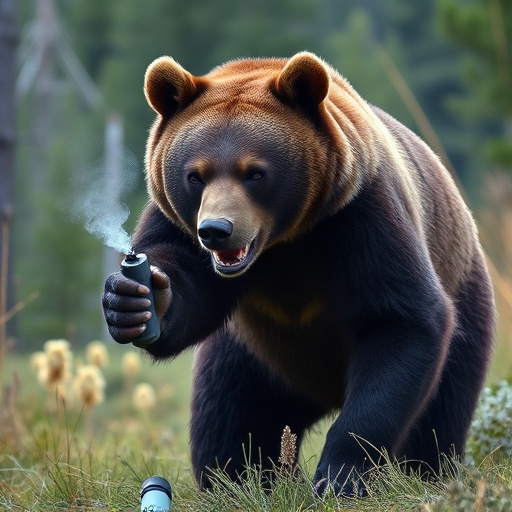Bear spray, a key safety tool for outdoor enthusiasts in bear country, comes with crucial legal requirements that vary state-by-state. Understanding local regulations on possession, use, and storage is essential to avoid legal issues and maximize the effectiveness of this deterrent against aggressive bears. Key considerations include age restrictions, permits, seasonal limitations, disposal guidelines, can size/weight, spray pattern, active ingredients, and environmental conditions, all impacting accessibility and practicality. Always research Bear Spray Legal Requirements by State before venturing into wilderness areas.
“Uncovering the Power of Bear Spray: A Comprehensive Guide. Bear encounters can be unpredictable, but understanding bear spray effectiveness is crucial for safety in wilderness areas. This article navigates the essentials of bear spray, including its mechanism and legal considerations like state-specific regulations (Bear Spray Legal Requirements by State). From selection to deployment, we explore factors ensuring its success against charging bears, offering insights for outdoor enthusiasts to make informed choices.”
- Understanding Bear Spray: What It Is and How It Works
- Legal Considerations: Bear Spray Regulations by State
- Effectiveness of Bear Spray Against Charging Bears
- Choosing the Right Bear Spray: Factors to Consider
Understanding Bear Spray: What It Is and How It Works
Bear spray, also known as bear repellent, is a specialized pepper spray designed to deter and protect against aggressive bears when hiking or camping in bear country. It’s a crucial tool for outdoor enthusiasts navigating regions with high bear populations. This spray contains capsaicin, the same active ingredient found in chili peppers, which irritates a bear’s eyes, nose, and throat, causing it to flee the area.
Understanding how bear spray works is essential, especially considering the legal requirements by state regarding its possession and use. In most areas, carrying bear spray is mandatory for outdoor activities in grizzly or black bear habitats. The legalities vary across states, with some requiring specific types, concentrations, or sizes of spray, while others have restrictions on where and how it can be carried. Knowing these regulations is vital to ensure compliance and maximize the spray’s effectiveness during potential encounters.
Legal Considerations: Bear Spray Regulations by State
When considering bear spray as a defense against charging bears, it’s crucial to understand the legal considerations and regulations that vary across states in the US. Bear spray is an important tool for outdoor enthusiasts and individuals living in areas with high bear populations, but its use comes with specific restrictions. Each state has its own set of rules regarding bear spray possession, usage, and storage, which can significantly impact your ability to protect yourself while outdoors.
The legal requirements for bear spray often include age restrictions on who can purchase it, licensing or permits needed for carrying it in certain areas, and limits on the quantity allowed. Some states also have specific seasons when bear spray use is permitted, aligned with peak bear activity periods. Additionally, proper storage and disposal methods are typically mandated to ensure safety and reduce environmental impact. It’s essential to review these Bear Spray Legal Requirements by State before heading into wilderness areas to ensure compliance and maximize your safety while outdoors.
Effectiveness of Bear Spray Against Charging Bears
Bear spray has been widely recognized as an effective deterrent against charging bears. When used properly, it can create a temporary blindness and irritation, giving the user valuable time to escape or defend themselves. The spray creates a barrier of capsaicin, the active ingredient, which disrupts the bear’s senses and reduces its aggression.
It’s important to note that while bear spray is a powerful tool, it’s not foolproof. Factors like wind direction, distance, and the bear’s individual temperament can affect its effectiveness. Additionally, legal requirements for carrying bear spray vary by state, so understanding local regulations regarding possession, use, and storage is crucial. Bear Spray Legal Requirements by State should be a primary consideration for anyone venturing into bear country.
Choosing the Right Bear Spray: Factors to Consider
When selecting bear spray, understanding its effectiveness against charging bears is just the first step. Equally crucial are considerations around legal requirements and specific factors that impact performance. Bear spray legality varies significantly by state, with some states mandating registration or prohibiting certain types of aerosol sprays altogether. Before purchasing, research local laws to ensure compliance and avoid potential fines or seizure of your bear spray.
Other key factors influence the effectiveness of bear spray. Key considerations include can size and weight, spray pattern and range, and active ingredients. A larger can may offer more protection but is less maneuverable. Spray patterns that cover a wider area are beneficial in crowded spaces like hiking trails. Active ingredients, such as capsaicin or oleoresin capsicum, determine the spray’s potency and how long it remains effective against bears. Understanding these factors allows you to choose bear spray tailored to your specific needs and environment.
Bear spray has proven to be an effective deterrent against aggressive bears, providing a valuable tool for outdoor enthusiasts in bear country. However, it’s crucial to understand that effectiveness depends on proper usage and knowledge of local legal requirements, which vary across states regarding Bear Spray Legal Requirements by State. Before venturing into bear country, ensure you’re familiar with the regulations in your area to make informed decisions about self-defense and safety.
